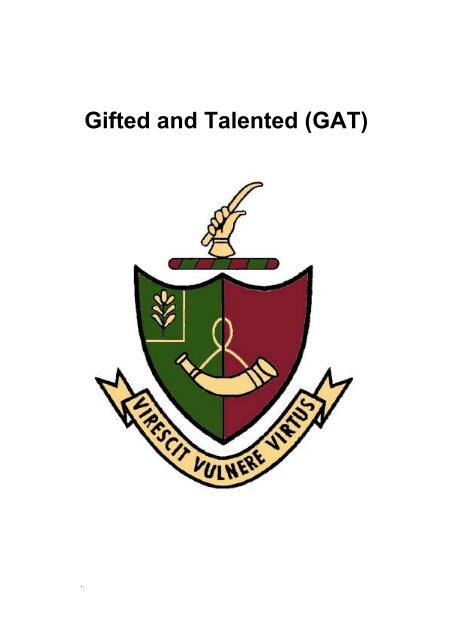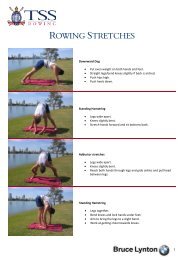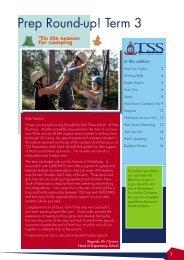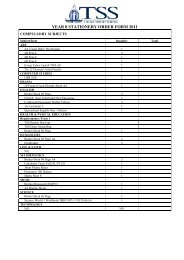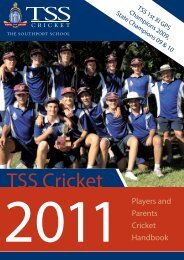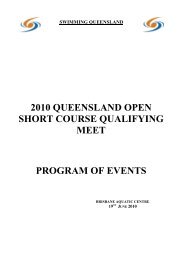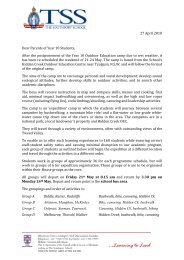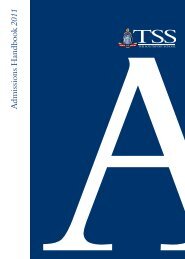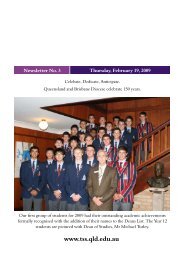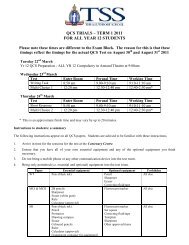Gifted and Talented (GAT)
Gifted and Talented (GAT)
Gifted and Talented (GAT)
Create successful ePaper yourself
Turn your PDF publications into a flip-book with our unique Google optimized e-Paper software.
<strong>Gifted</strong> <strong>and</strong> <strong>Talented</strong> (<strong>GAT</strong>)<br />
Prep <strong>GAT</strong> 0
Table of Contents<br />
PREP GIFTED AND TALENTED (<strong>GAT</strong>): VISION..................................................... 2<br />
PREP GIFTED AND TALENTED: RECOGNISING <strong>GAT</strong> STUDENTS..................... 3<br />
GUIDELINES FOR RECOGNISING POSSIBLE <strong>GAT</strong> STUDENTS:.............................................. 3<br />
THE SIX PROFILES OF <strong>GAT</strong> STUDENTS:............................................................................. 3<br />
PREP GIFTED AND TALENTED: REFERRAL PROCEDURES .............................. 4<br />
PARENT NOMINATION FORM:............................................................................................ 5<br />
TEACHER NOMINATION FORM: ......................................................................................... 7<br />
PREP GIFTED AND TALENTED: DIFFERENTIATION.......................................... 9<br />
GROUPING STRATEGIES:................................................................................................... 9<br />
Examples of grouping strategies:................................................................................ 9<br />
The............................................................................................................................... 9<br />
CURRICULUM: ................................................................................................................ 10<br />
Examples of management strategies for curriculum differentiation within the<br />
classroom: ................................................................................................................. 10<br />
WHAT IS CURRICULUM DIFFERENTIATION..................................................................... 11<br />
PREP GIFTED AND TALENTED: REFERENCES................................................... 12<br />
Prep <strong>GAT</strong> 1
Prep <strong>Gifted</strong> <strong>and</strong> <strong>Talented</strong> (<strong>GAT</strong>): Vision<br />
TSS Prep’s commitment to all boys is to provide them with encouragement,<br />
support <strong>and</strong> opportunities to achieve their best.<br />
Our vision for <strong>Gifted</strong> <strong>and</strong> <strong>Talented</strong> boys is that they feel supported <strong>and</strong><br />
encouraged by a community which fosters a learning environment that both<br />
challenges <strong>and</strong> supports the boys to pursue excellence <strong>and</strong> develop a passion<br />
for lifelong learning.<br />
We aim to:<br />
1. empower the boys who have been identified as <strong>Gifted</strong> <strong>and</strong> <strong>Talented</strong>,<br />
<strong>and</strong> provide them with opportunities <strong>and</strong> programs to reach their full<br />
potential;<br />
2. identify double labeled or underachieving <strong>Gifted</strong> <strong>and</strong> <strong>Talented</strong> students<br />
3. be dynamic in our approach to accommodate the individual needs of<br />
our boys;<br />
4. provide a pathway for TSS Prep students to enter the <strong>GAT</strong>/ Honors<br />
Program at the Senior School<br />
5. support the teachers in developing differentiated programs to meet the<br />
needs of the <strong>Gifted</strong> <strong>and</strong> <strong>Talented</strong>;<br />
6. provide information that increases the underst<strong>and</strong>ing within the Prep<br />
community of what it means to be a <strong>Gifted</strong> <strong>and</strong> <strong>Talented</strong> student; <strong>and</strong><br />
7. foster a culture, within TSS Prep, that values high academic<br />
achievement.<br />
Prep <strong>GAT</strong> 2
Prep <strong>Gifted</strong> <strong>and</strong> <strong>Talented</strong>: Recognising <strong>GAT</strong> students<br />
Guidelines for recognising possible <strong>GAT</strong> students:<br />
The following characteristics are indications of potential <strong>GAT</strong> students. However,<br />
caution should be used when interpreting student’s behaviour – it is the<br />
frequency, intensity <strong>and</strong> combination of behaviours which provides evidence of<br />
giftedness.<br />
The six profiles of <strong>GAT</strong> students:<br />
(Betts & Neihart, 1988)<br />
Profile<br />
TYPE I, The High Achiever<br />
TYPE II, The Challenger<br />
TYPE III, The Underground<br />
Student<br />
TYPE IV, The Dropout<br />
TYPE V, Double Labelled<br />
TYPE VI, Autonomous Learner<br />
Characteristics<br />
• Most commonly identified as <strong>GAT</strong>.<br />
• Well liked with high level outcomes<br />
• Dependent rather than independent.<br />
• Not risk takers.<br />
• Could achieve more if more selfdetermining.<br />
• Usually highly creative.<br />
• Lack of support can result in rebellious<br />
behaviour.<br />
• Challenges any authority figure<br />
including parents.<br />
• Tries to hide giftedness.<br />
• Often in the middle years of schooling.<br />
• Anxious <strong>and</strong> insecure.<br />
• Long history of underachievement.<br />
• Requires substantial support.<br />
• Often at this stage as a result of demotivation<br />
due to inappropriate<br />
programs.<br />
• May have physical, emotional or<br />
learning difficulty.<br />
• Often impairment given attention whilst<br />
gift is ignored.<br />
• Independent <strong>and</strong> self directed.<br />
• Develop with appropriate program.<br />
Prep <strong>GAT</strong> 3
Prep <strong>Gifted</strong> <strong>and</strong> <strong>Talented</strong>: Referral procedures<br />
Teacher<br />
Awareness of possible <strong>GAT</strong> required<br />
through interaction with the student or<br />
Admissions<br />
Admissions<br />
Teacher to gather information<br />
indicating suspected strength<br />
Teacher to modify program/<br />
approaches/ strategies etc.<br />
Note: Teachers<br />
seek support from<br />
teaching peers as<br />
well as informal<br />
discussions with<br />
<strong>GAT</strong> team <strong>and</strong><br />
informal parent<br />
interviews/ chats<br />
Permission to gather information from<br />
external professionals is sought<br />
Parents complete nomination form<br />
Student may be viewed in their<br />
current educational setting<br />
Formal referral to <strong>GAT</strong><br />
via teacher nomination<br />
form <strong>and</strong> parent<br />
nomination form 1<br />
accompanied by<br />
information gathered<br />
<strong>GAT</strong> investigates case further <strong>and</strong><br />
with the class teacher works to<br />
identify the needs of the child <strong>and</strong><br />
further adjustments needed<br />
<strong>GAT</strong> <strong>and</strong> class teacher offer<br />
amended program<br />
Strength extended<br />
Note: Although it is currently not<br />
a legal requirement to keep a<br />
proof of adjustment folder for<br />
each identified student – it is<br />
coming <strong>and</strong> it may be a good<br />
idea to start getting into the<br />
habit. Alternatively, the portfolio<br />
is a good medium to document<br />
proof of adjustments.<br />
Outline of how TSS would be able to<br />
provide <strong>and</strong> accommodate alternative<br />
education<br />
<strong>GAT</strong> investigates case further <strong>and</strong><br />
with the class teacher works to<br />
identify the needs of the child <strong>and</strong><br />
adjustments needed<br />
<strong>GAT</strong> <strong>and</strong> class teacher offer<br />
amended program<br />
Note: Because each case is so unique <strong>and</strong> dynamic, the flow of this process will<br />
vary greatly according to each individual case.<br />
1 Teacher <strong>and</strong> parent nomination forms can be downloaded from the <strong>GAT</strong> website or copied from this h<strong>and</strong>book<br />
Prep <strong>GAT</strong> 4
Parent nomination form:<br />
Nomination by parent or caregiver<br />
Child’s name:_______________________________________ Child’s Class: ________________________<br />
Name of Parent/Caregiver:________________________________________________________________<br />
Your relationship to child: ____________________________ Child’s Age (Year/months): _____________<br />
Please tick the appropriate boxes:<br />
Characteristic Most of the time Some of the time Rarely<br />
• Recalls facts easily <br />
• Express himself fluently <br />
• Is always asking questions <br />
• Has a well developed sense of<br />
humour<br />
<br />
• Finds unusual uses for things<br />
<strong>and</strong> is inventive <br />
• Tends to lead/initiate activities <br />
• Is curious <br />
• Has a long attention span <br />
• Is easily bored <br />
• Is an avid reader <br />
• Underst<strong>and</strong>s things well enough<br />
to teach them to you or others<br />
• Mixes with older children <strong>and</strong><br />
adults easily<br />
<br />
<br />
• Is impulsive <br />
• Is an independent learner <br />
• Is concerned about world issues <br />
Prep <strong>GAT</strong> 5
PLEASE COMPLETE THE FOLLOWING QUESTIONS:<br />
When did your child first talk<br />
When did your child first learn to read<br />
At what age did your child show an underst<strong>and</strong>ing of numbers, puzzles <strong>and</strong> patterns<br />
How many books <strong>and</strong> magazines would your child voluntarily read in a month<br />
If your child has any intense interests or hobbies, what are they<br />
What type of television programs does your child like to watch<br />
If your child has an interest in music, what is he learning <strong>and</strong> what level has been attained<br />
In what activities does your child participate outside school hours<br />
Would you consider that your child has a particular problem or need that may affect his learning<br />
Has your child painted, built or constructed something which seemed beyond his age<br />
Please add any other information you may feel relevant to your child’s nomination, e.g. photos of his art, constructions,<br />
educational reports, examples of your child performing above the expected level for his peer group, etc.<br />
Prep <strong>GAT</strong> 6
Teacher nomination form:<br />
TEACHER NOMINATION FORM:<br />
PRIMARY AND SECONDARY<br />
Student Name: ………………………….<br />
Teacher: ………………………………….<br />
Age: ……………………….<br />
Date: ………………………<br />
Use a highlighter to show each behaviour you observe in the classroom or<br />
playground.<br />
CHARACTERISTICS POSITIVE BEHAVIOURS NE<strong>GAT</strong>IVE BEHAVIOURS<br />
Highly curious<br />
Abstract thinker<br />
Flexible thinker<br />
Clever use of humour<br />
Superior vocabulary<br />
Advanced reading<br />
• Asks lots of questions<br />
• Inquisitive<br />
• Remembers details<br />
• Makes generalisations<br />
• Tests out ideas<br />
• Employs variety of strategies to<br />
work something out<br />
• Enjoys ‘adult humour’<br />
• Gets teachers jokes!<br />
• Heightened involvement in the<br />
discussions<br />
• Enjoys adult-like discussions<br />
• Reads widely<br />
• Advanced vocabulary<br />
• Advanced comprehension<br />
• Asks inappropriate questions<br />
• Poor group participant<br />
• Easily diverted from task<br />
• Questions others<br />
• Questions authority<br />
• Manipulates people <strong>and</strong> situations<br />
by using a variety of strategies<br />
• Uses humour at the expense of<br />
others<br />
• May be bossy or overbearing when<br />
working with others<br />
• Reads constantly<br />
• Neglects peer interaction <strong>and</strong> work<br />
Retention of knowledge;<br />
fast learner<br />
Long attention span<br />
Independent<br />
High level of<br />
responsibility <strong>and</strong><br />
commitment<br />
• Moves beyond core content <strong>and</strong><br />
skills quickly<br />
• Detailed recall of facts<br />
• Concentrates <strong>and</strong> focuses on an<br />
area of interest for a long period of<br />
time<br />
• Self directed<br />
• Focused on task in research or<br />
study<br />
• Sets attainable goals<br />
• Learns to accept own limitations<br />
• Tolerant of peers in a group<br />
• Rushes work, then disrupts others<br />
• Monopolises class discussions<br />
• Easily distracted unless the task is<br />
an area of passion or interest<br />
• Reduced involvement in discussion<br />
or group work<br />
• Uncooperative in a group<br />
• Self critical<br />
• Perfectionist when completing tasks<br />
• Sets unrealistic expectations for<br />
other group members<br />
Prep <strong>GAT</strong> 7
Strong feelings <strong>and</strong><br />
opinions<br />
Strong sense of justice<br />
Original <strong>and</strong> creative<br />
Immersion learner<br />
• Listens to others<br />
• Shows concern <strong>and</strong> interest<br />
• Considers others’ points of view<br />
• Aware of others’ feelings<br />
• Empathises with those less<br />
fortunate<br />
• Wants to ‘save the world’<br />
• St<strong>and</strong>s up for other children whom<br />
they think have been treated poorly<br />
• Comes up with ideas “out of the<br />
box”<br />
• Sees problems as a whole<br />
• Connects thoughts <strong>and</strong> feelings<br />
• Wants to know everything about a<br />
topic<br />
• Becomes an expert on a topic by<br />
reading widely or talking to people<br />
• Speaks out <strong>and</strong> lacks tact<br />
• Over-reacts to others’ comments<br />
<strong>and</strong> reactions<br />
• Confrontational<br />
• Argues the rules of the game, e.g.<br />
h<strong>and</strong>ball<br />
• Frustration when others don’t play<br />
exactly by rules<br />
• Asks older children or adults to solve<br />
issues seen as “unfair”<br />
• Unaccepting of status quo<br />
• Absent-minded or daydreamer<br />
• Asks unrelated questions<br />
• Disorganised<br />
• Focuses on topics of interest to<br />
them, at the expense of classroom<br />
work<br />
• Shows off knowledge to prove others<br />
wrong<br />
Adapted from Caroline Merrick (2004) Gross, MacLeod, Drummond & Merrick<br />
(2001), Clark (1983) <strong>and</strong> Baska (1989).<br />
Scoring the Checklist<br />
How many positive behaviours are being displayed ………………………………<br />
How many negative behaviours are being displayed ……………………………..<br />
Have you highlighted behaviour in more than five different behaviour boxes Y/N<br />
Of which behaviours are you observing more<br />
POSITIVE/ NE<strong>GAT</strong>IVE<br />
Conclusion<br />
________________________________________________________________<br />
________________________________________________________________<br />
________________________________________________________________<br />
________________________________________________________________<br />
________________________________________________________________<br />
________________________________________________________________<br />
________________________________________________________________<br />
________________________________________________________________<br />
Prep <strong>GAT</strong> 8
Prep <strong>Gifted</strong> <strong>and</strong> <strong>Talented</strong>: Differentiation<br />
Grouping strategies:<br />
At Prep, we value grouping (by ability or achievement), as a form of instructional<br />
management that fosters differentiation of the curriculum.<br />
The <strong>GAT</strong> students learning potential is more likely to be maximized when he<br />
spends learning time with other students of a similar ability. Grouping also offers<br />
social <strong>and</strong> emotional benefits for the <strong>GAT</strong> student as he is spending time with<br />
children “like him”, bringing social confidence through a feeling of belonging.<br />
Examples of grouping strategies:<br />
Multi-age classroom<br />
Students are grouped by their achievement level in a subject rather than<br />
by grade or age level<br />
Regrouping by achievement for subject instruction<br />
Students are sorted according to their subject ability or achievement into<br />
different classes.<br />
A cluster-grouped class<br />
The top high ability students are placed in the same class, where they can<br />
access a differentiated curriculum<br />
Within-class performance grouping<br />
Sorting of students by topic or subject provides differentiated learning for<br />
each group<br />
Co-operative grouping with like ability learners<br />
Groups of learners are organised in three-to-four-member teams <strong>and</strong> the<br />
group task is adjusted accordingly<br />
A withdrawal program for children gifted in specific subject areas<br />
Students are regularly withdrawn from class<br />
(Adapted from: Rogers, (2002)<br />
Prep <strong>GAT</strong> 9
Curriculum:<br />
Grouping alone will not reap benefits for the <strong>GAT</strong> student, they need access to a<br />
developmentally appropriate curriculum (Rogers, 2002). Provisions for a <strong>GAT</strong><br />
boy are an important component (<strong>and</strong> soon legal requirement) of the class<br />
program. Short term, ad hoc adjustments that are not related to the core<br />
curriculum are basically a waste of everybody’s time.<br />
The curriculum for <strong>GAT</strong> students should be challenging, stimulating <strong>and</strong> dynamic,<br />
aiming to meet the individual needs of the boy.<br />
Educational programs for <strong>GAT</strong> students may contain:<br />
• content acceleration to match students’ abilities<br />
• thoughtfully planned relevant enrichment<br />
• the opportunity to work with peers of similar ability<br />
• the opportunity to work with mentors, who have high levels of<br />
expertise.<br />
Examples of management strategies for curriculum differentiation<br />
within the classroom:<br />
Individual educational plan<br />
A written plan for managing <strong>and</strong> delivering the curriculum for an<br />
exceptional child<br />
Talent development<br />
Provision of opportunities for a high-ability or talented student, through<br />
either individual work or work in a like-ability group<br />
Individual mentoring or tutoring<br />
An opportunity to engage intellectually in an area of deep interest with an<br />
expert<br />
Independent study<br />
Structured projects that enable a student to investigate individually an<br />
area of interest<br />
Prep <strong>GAT</strong> 10
What is curriculum differentiation<br />
Differentiation ranges from slight to major modifications of the curriculum through<br />
adjustments to content, processes <strong>and</strong> skills. It provides a planned, documented<br />
<strong>and</strong> challenging curriculum that matches the ability of gifted students to:<br />
• learn at faster rates<br />
• find, solve <strong>and</strong> act on problems more readily<br />
• manipulate abstract ideas <strong>and</strong> make connections to an advanced<br />
degree<br />
Differentiation should include enrichment <strong>and</strong> extension activities. Enrichment<br />
refers to the broadening of the curriculum to develop knowledge, application,<br />
thinking skills <strong>and</strong> attitudes, to a degree of complexity appropriate to the<br />
student’s developmental level (Braggett, 1997). Enrichment activities need to be<br />
written into unit planners to ensure all students have access to them. Extension<br />
activities involve the deepening of students’ knowledge, underst<strong>and</strong>ing <strong>and</strong> skills.<br />
A differentiated curriculum is a program of activities that offers a variety of entry<br />
points for students who differ in abilities, knowledge <strong>and</strong> skills. In a differentiated<br />
curriculum, teachers offer different approaches to what students learn (content),<br />
how students learn (process) <strong>and</strong> how students demonstrate what they have<br />
learned (product). Differentiated instruction is a mix of whole-class, group <strong>and</strong><br />
individualised activities. (NSW Department of Education <strong>and</strong> Training, 2004)<br />
Differentiated programming is:<br />
• having high expectations for each student;<br />
• permitting students to demonstrate mastery of material they already know<br />
<strong>and</strong> to progress at their own pace through new material;<br />
• providing different avenues to acquiring content, to processing or making<br />
sense of ideas, <strong>and</strong> to developing products;<br />
• providing multiple assignments within each unit, tailored for students with<br />
differing levels of achievement;<br />
• allowing students to choose, with the teacher’s guidance, ways to learn<br />
<strong>and</strong> how to demonstrate what they have learned; <strong>and</strong><br />
• flexible: teachers move students in <strong>and</strong> out of groups, based on students’<br />
instructional needs.<br />
(Adapted from Tomlinson & Allan, 2000)<br />
Prep <strong>GAT</strong> 11
Prep <strong>Gifted</strong> <strong>and</strong> <strong>Talented</strong>: References<br />
Braggett, E. (1997). Differentiated programs for secondary schools: Units of work for<br />
gifted <strong>and</strong> talented students. Highett, Vic.: Hawker Brownlow Education.<br />
Rogers, K.B. (2002). Re-forming gifted education: Matching the program to the child.<br />
Scottsdale, AZ: Great Potential Press.<br />
State of NSW, Department of Education <strong>and</strong> Training. (2004). Policy <strong>and</strong> implementation<br />
strategies for the education of gifted <strong>and</strong> talented students, NSW Department of<br />
Education <strong>and</strong> Training.<br />
Tomlinson, C.A. & Allan, S.D. (2000). Leadership for differentiating schools <strong>and</strong><br />
classrooms. Alex<strong>and</strong>ria, VA: ASCD<br />
Prep <strong>GAT</strong> 12


